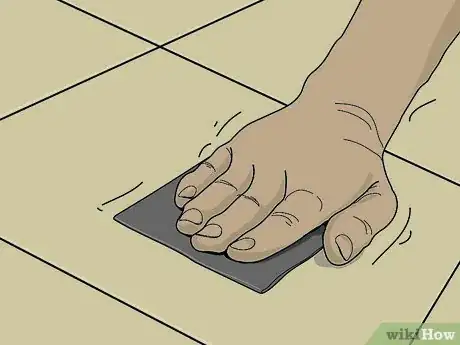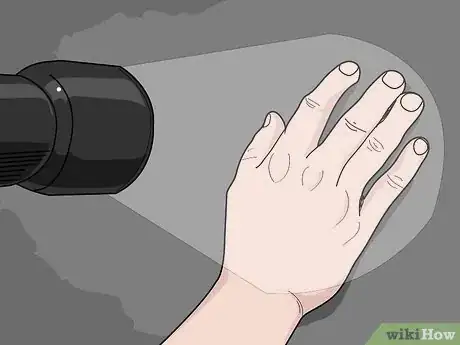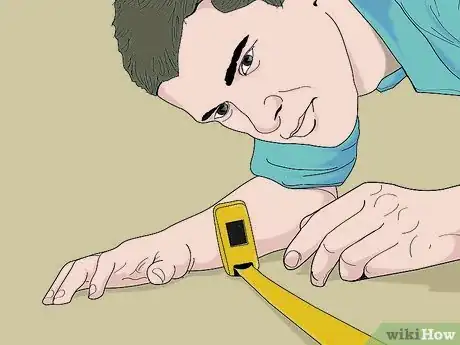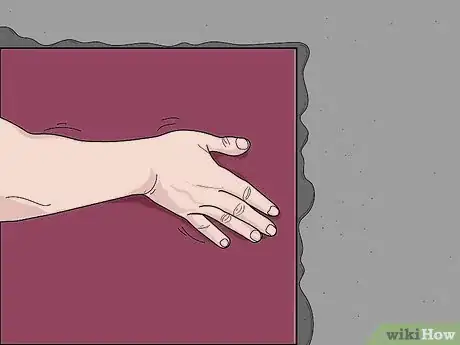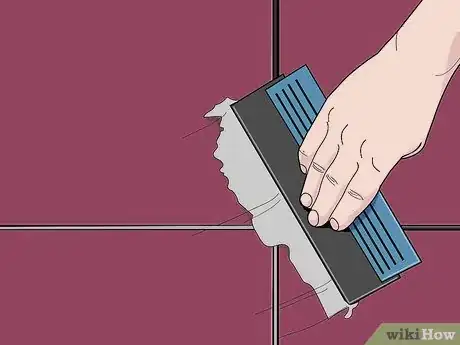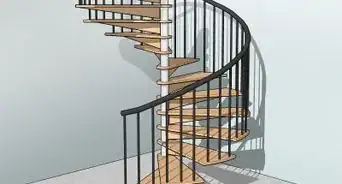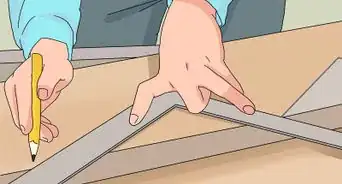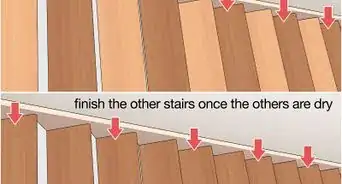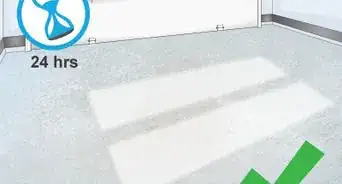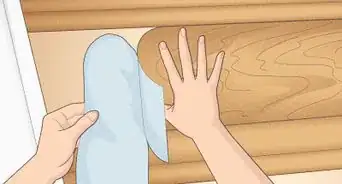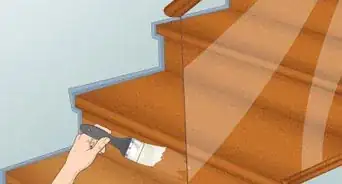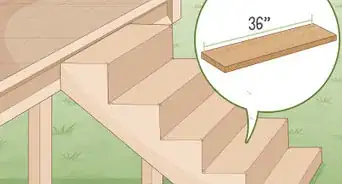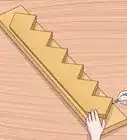This article was co-authored by Sam Adams. Sam Adams is the owner of Cherry Design + Build, a residential design and construction firm, which has been operating in the Greater Seattle Area for over 13 years. A former architect, Sam is now a full-service contractor, specializing in residential remodels and additions.
This article has been viewed 29,441 times.
Installing a new tile floor is a great way to update a space. If the old tiles and subfloor are in good shape, then you can tile directly over them. Or, you can pull up the flooring and start over entirely from scratch. To lay your tiles, start by deciding on a pattern. Then, apply thin-set to the floor and set each tile down individually. Keep going until your floor is finished, wipe it down with a wet sponge, and admire your work.
Steps
Using the Old Tile Floor as a Base
-
1Decide whether or not to tile directly on top of the prior layer. If the old tile is securely installed and in good condition, you can save yourself a lot of time by just laying new tile on top of it. However, the floor level will change a bit. If you rip up the old tile, it will take more time, but you can guarantee that the subfloor is secure.[1]
-
2Tap each old tile lightly to check for looseness. Get a small wood mallet and tap the center of each tile. Listen closely to the noise that follows. If it sounds hollow, then you need to pull up the tile, spread a layer of thin-set underneath it, and press it back down.[2]Advertisement
-
3Check the floor for levelness. Place a level down on the floor. Look at it to see if the floor reads out as perfectly level. Move your level device around to check all parts of the room. If there are high points in the room, use a masonry grinder to grind them down. If there are low points, plan to build them up with some extra thin-set before laying your new tile.[3]
-
4Sand the old tiles down. Get an 80-grit or rougher sand paper. Go over the room, sanding each area until all of the tile is a bit rough on the surface. Use a broom or vacuum to pick up any dust left over from sanding. The rougher texture of the tile will help the new tile to attach more securely to the floor.[4]
- Before you start working, put on a pair of construction goggles to protect your eyes. Don protective gloves that fit you well, if you are worried about skin irritation.
Removing the Old Tiles Instead
-
1Pry up the existing tiles. Place a chisel at the edge of the tile at an angle. Hit the back of the chisel with a hammer slowly and continue until the tile begins to break apart. Continue as you move across the entire floor. Throw the broken tile pieces into a wastebasket.[5]
- Another option is to simply hit each tile in the center with a sledgehammer. This will create more pieces, but can be a quick way to pull up a floor.
- Chisels and sledgehammers should work on most tile floor materials, including ceramic and most natural stones.
- Wearing a mask can protect you from any small dust particles kicked into the air as you pull up the tiles. It’s also a good idea to wear long pants and sleeves to protect your arms and legs from scrapes or cuts. Protect your knees when removing or laying tile by wearing pads or padded pants.[6]
-
2Scrub the floor with a stripper. Use a floor stripping solution purchased from your local hardware or home improvement store. Apply the stripper to the floor as directed. Wait until it takes full effect and then use an abrasive scouring pad to scrub loose any stuck on debris or glue. Keep going until the floor is fairly smooth to the touch.[7]
-
3Inspect and repair the subfloor. Once you’ve removed the tiles and any associated grime, take a close look at your floor with a work light. If the floor is wood, see if there are any areas that are rotten or warped. You’ll need to replace these spots with fresh wood. If the concrete subfloor is slightly cracked, sand it down with an abrasive pad.[8]
- Replacing any damaged wood sections is a great way to prevent a future mold problem, especially in bathrooms or kitchens. Just make sure that you address the cause of any leaks as well.
Choosing Your Tiles and Layout
-
1Measure the size of your floor. Get out a tape measure and write down the length and width of the room. Measure twice just to be careful. Multiply these 2 numbers and you’ll have the square footage of the space. Look at the square footage covered by a box of tile or a single tile. Divide your floor’s square footage by the amount contained in each box and this will tell you how many boxes you’ll need to buy.[9]
- For example, if your room is 150 square feet and each box covers 10 square feet, you’ll need to buy 15 boxes to cover the floor. It’s also best to buy an extra 10% of tile, so that you have some room for error, too.
-
2Choose your replacement tile. Create a construction budget, so you know how much you can spend. Then, use your room measurements to determine what type of tile you’ll buy. You’ll also want to consider the style of the space, the ease of installation, and the durability of the tile type.[10]
- A single tile generally costs between $5 to $15 a square foot. Keep in mind your other construction expenses too, such as grout.
-
3Dry-lay the tile to see how it looks. Set the tiles out on the floor in the planned pattern. Try to get a feel for where you’ll need to use the tile cutter to break full-size tiles down into smaller pieces. This is also the time to move the tiles around to experiment with different patterns. After you look everything over, you can either leave the tiles down or pick them up and reapply them later.[11]
- Pay particular attention to entryways. Small pieces of tile can sometimes look awkward in these spaces, so you may need to rearrange to guard against this.
Installing Your New Tiles
-
1Comb the thin-set onto the floor. Dip your trowel into the bucket of thin-set and spread it out across the floor. Move your trowel in the same direction, to reduce the possibility of air pockets. If there were low spots in the floor that you marked earlier, you may need to apply extra thin-set to those areas.[12]
-
2Set each tile down and wiggle it a bit. Hold the tile above its future spot and drop it down gently and slowly. Move it just a bit side-to-side to secure the tile to the floor. Tap the top of the tile with a wooden hammer as well. Place a level on top of the tile to verify that the tile is level. Continue until all the tiles are placed.[13]
- Thin-set starts to dry immediately. If you need to peel up a tile and move it, you’ll need to do so almost immediately or risk having to chisel away hardened thin-set. The thin-set will be totally dry within 24-48 hours.
-
3Use a tile cutter to make smaller tile pieces. You can either rent a cutter or buy a hand-held one from a home improvement store. You’ll likely need to cut tiles to complete the edges of your floor. Hold a full tile under the cutter and run the scoring wheel across the top. Next, push down on the cutter’s handle until the tile snaps along the scoring line.[14]
- Other options for cutting tile include using a wet saw or glass cutting tool.
-
4Inspect each section of tile before moving on. After you finish four or more tiles, stand up and take a few steps back. Look down to see if the tiles appear in proper alignment. Place a level across the tiles to make sure it is even. Take this opportunity to clean away any thin-set from the tile’s surface with a damp sponge as well.[15]
-
5Work the grout into the joints. When all of the tiles are placed, mix your grout in a bucket according to the package directions. Use a trowel and grout float to press the grout in between each tile. Wipe away any excess from the tile’s surface before it hardens by using your trowel and a sponge. When you are finished, let the grout dry for two days before walking on it.[16]
- Don’t add too much water to your grout. It should be similar in texture to cake batter.
Expert Q&A
-
QuestionHow do you replace a broken floor tile?
 Sam AdamsSam Adams is the owner of Cherry Design + Build, a residential design and construction firm, which has been operating in the Greater Seattle Area for over 13 years. A former architect, Sam is now a full-service contractor, specializing in residential remodels and additions.
Sam AdamsSam Adams is the owner of Cherry Design + Build, a residential design and construction firm, which has been operating in the Greater Seattle Area for over 13 years. A former architect, Sam is now a full-service contractor, specializing in residential remodels and additions.
Professional Contractor You should remove the grout around the tile and then smash the tile with a hammer, pulling the pieces out. Next, split the mortar underneath the tile. You can actually glue the next piece of tile on the spot of the old one using an epoxy. Make sure you grout the new tile immediately.
You should remove the grout around the tile and then smash the tile with a hammer, pulling the pieces out. Next, split the mortar underneath the tile. You can actually glue the next piece of tile on the spot of the old one using an epoxy. Make sure you grout the new tile immediately.
Warnings
- Be careful when handling cut or broken tiles. Their edges can be very sharp and can cut your hands or fingers quite easily.[17]⧼thumbs_response⧽
References
- ↑ https://www.angieslist.com/articles/tile-flooring-rip-or-just-replace.htm
- ↑ https://www.angieslist.com/articles/tile-flooring-rip-or-just-replace.htm
- ↑ https://www.angieslist.com/articles/tile-flooring-rip-or-just-replace.htm
- ↑ https://www.angieslist.com/articles/tile-flooring-rip-or-just-replace.htm
- ↑ https://www.allthingsthrifty.com/2015/01/how-to-remove-tile-flooring-yourself-with-tips-and-tricks.html
- ↑ https://www.familyhandyman.com/floor/install-a-ceramic-tile-floor-in-the-bathroom/view-all/
- ↑ https://www.familyhandyman.com/floor/install-a-ceramic-tile-floor-in-the-bathroom/view-all/
- ↑ https://www.angieslist.com/articles/tile-flooring-rip-or-just-replace.htm
- ↑ https://www.familyhandyman.com/floor/install-a-ceramic-tile-floor-in-the-bathroom/view-all/
- ↑ https://www.familyhandyman.com/floor/install-a-ceramic-tile-floor-in-the-bathroom/view-all/
- ↑ https://www.familyhandyman.com/floor/install-a-ceramic-tile-floor-in-the-bathroom/view-all/
- ↑ https://www.familyhandyman.com/floor/install-a-ceramic-tile-floor-in-the-bathroom/view-all/
- ↑ https://www.washingtonpost.com/news/where-we-live/wp/2015/01/06/ask-the-builder-how-to-replace-broken-ceramic-floor-tile/?utm_term=.9965bf1dd2c2
- ↑ https://www.familyhandyman.com/floor/install-a-ceramic-tile-floor-in-the-bathroom/view-all/
- ↑ https://www.familyhandyman.com/floor/install-a-ceramic-tile-floor-in-the-bathroom/view-all/
- ↑ https://www.bobvila.com/articles/how-to-remove-grout-regrouting-tile/#.Wgu1Hmi3zIU
- ↑ https://www.allthingsthrifty.com/2015/01/how-to-remove-tile-flooring-yourself-with-tips-and-tricks.html



